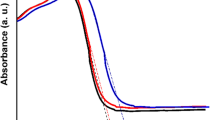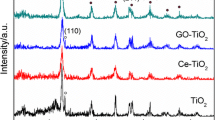Abstract
Reduced graphene oxide (rGO)-copper tin sulfide (Cu2SnS3), (rGO-CTS), composites were successfully synthesized through a facile ex-situ process and the obtained composites were utilized as photocatalysts for the degradation of tetracycline (TCE) under a UV-LED irradiation. Physicochemical and morphological characterization of the composites confirmed the incorporation of CTS unto rGO. The optical study of the composites, using absorption spectroscopy, showed a red shift to lower energy with increase in the percentage of rGO in the composites. This reduction in band gap suggests a possible enhancement in photocatalytic potency due to enhanced charge carrier generation. The photocatalytic degradation study showed an increase in TCE degradation with increase in rGO content of the composite. This enhanced photocatalytic activity could be ascribed to: (i) enhanced adsorption properties due to the increased presence of oxygenated functional groups on rGO, and (ii) increased charge carrier generation and separation due to modification of the band edge potentials of the composites by the incorporation of rGO. Radical scavenging studies of the degradation process showed that photogenerated holes played the most significant role in the degradation process. A plausible mechanism was proposed for the degradation process based on the radical scavenging experiment and charge carrier characteristics of the catalyst.












Similar content being viewed by others
References
V. Kumar, K. Singh, M. Shah, Advanced Oxidation Processes for Complex Wastewater Treatment (Elsevier, New York, 2021), pp. 1–31
J.O. Tijani, O.O. Fatoba, G. Madzivire, L.F. Petrik, A review of combined advanced oxidation technologies for the removal of organic pollutants from water. Water Air Soil Pollut. 225, 2102 (2014)
H. Liu, C. Wang, G. Wang, Photocatalytic advanced oxidation processes for water treatment: recent advances and perspective. Chemistry 15, 3239–3253 (2020)
A. Tufail, W.E. Price, F.I. Hai, A critical review on advanced oxidation processes for the removal of trace organic contaminants: a voyage from individual to integrated processes. Chemosphere 260, 127460 (2020)
M.A. Oturan, J.-J. Aaron, Advanced oxidation processes in water/wastewater treatment: principles and applications a review. Crit. Rev. Environ. Sci. Technol. 44, 2577–2641 (2014)
Y. Deng, R. Zhao, Advanced oxidation processes (AOPs) in wastewater treatment. Curr. Pollut. Rep. 1, 167–176 (2015)
S. Khan, M. Sayed, M. Sohail, L.A. Shah, M.A. Raja, Chapter 6—advanced oxidation and reduction processes, in Advances in Water Purification Techniques. ed. by S. Ahuja (Elsevier, 2019), pp. 135–164
T. Li, C. Wang, T. Wang, L. Zhu, Highly efficient photocatalytic degradation toward perfluorooctanoic acid by bromine doped BiOI with high exposure of (001) facet. Appl. Catal. B 268, 118442 (2020)
T. Xu, Y. Zhu, J. Duan, Y. Xia, T. Tong, L. Zhang, D. Zhao, Enhanced photocatalytic degradation of perfluorooctanoic acid using carbon-modified bismuth phosphate composite: effectiveness, material synergy and roles of carbon. Chem. Eng. J. 395, 124991 (2020)
V. Likodimos, Advanced photocatalytic materials. Materials (Basel) 13, 821 (2020)
C.-C. Wang, J.-R. Li, X.-L. Lv, Y.-Q. Zhang, G. Guo, Photocatalytic organic pollutants degradation in metal–organic frameworks. Energy Environ. Sci. 7, 2831–2867 (2014)
S. Kumar, W. Ahlawat, G. Bhanjana, S. Heydarifard, M. Nazhad, N. Dilbaghi, Nanotechnology-based water treatment strategies. J. Nanosci. Nanotechnol. 14, 1838–1858 (2014)
M.M. Khan, S.F. Adil, A. Al-Mayouf, Metal oxides as photocatalysts. J. Saudi Chem. Soc. 19, 462–464 (2015)
M.B. Tahir, M. Rafique, M.S. Rafique, N. Fatima, Z. Israr, Chapter 6—metal oxide- and metal sulfide-based nanomaterials as photocatalysts, in Nanotechnology and Photocatalysis for Environmental Applications. ed. by M.B. Tahir, M. Rafique, M.S. Rafique (Elsevier, 2020), pp. 77–96
H. Hao, X. Lang, Metal sulfide photocatalysis: visible-light-induced organic transformations. ChemCatChem 11, 1378–1393 (2019)
K. Sharma, V. Dutta, S. Sharma, P. Raizada, A. Hosseini-Bandegharaei, P. Thakur, P. Singh, Recent advances in enhanced photocatalytic activity of bismuth oxyhalides for efficient photocatalysis of organic pollutants in water: a review. J. Ind. Eng. Chem. 78 (2019).
H. Kim, D. Jang, S. Choi, J. Kim, S. Park, Acid-activated carbon nitrides as photocatalysts for degrading organic pollutants under visible light. Chemosphere 273, 129731 (2021)
C.-H. Lai, M.-Y. Lu, L.-J. Chen, Metal sulfide nanostructures: synthesis, properties and applications in energy conversion and storage. J. Mater. Chem. 22, 19–30 (2012)
V. Robles, J.F. Trigo, C. Guillén, J. Herrero, Copper tin sulfide (CuxSnSy) thin films evaporated with x=3,4 atomic ratios: Influence of the substrate temperature and the subsequent annealing in sulfur. Mater. Res. Bull. 83, 116–121 (2016)
A.C. Lokhande, P.T. Babar, V.C. Karade, M.G. Gang, V.C. Lokhande, C.D. Lokhande, J.H. Kim, The versatility of copper tin sulfide. J. Mater. Chem. A 7, 17118–17182 (2019)
M.T.S. Nair, C. Lopz-Mata, O. GomezDaza, P.K. Nair, Copper tin sulfide semiconductor thin films produced by heating SnS–CuS layers deposited from chemical bath. Semicond. Sci. Technol. 18, 755–759 (2003)
Q. Chen, D. Ma, Preparation of nanostructured Cu2SnS3 photocatalysts by solvothermal method. Int. J. Photoenergy 2013 (2013).
X. Liang, Q. Cai, W. Xiang, Z. Chen, J. Zhong, Y. Wang, M. Shao, Z. Li, Preparation and characterization of flower-like Cu2SnS3 nanostructures by solvothermal route. J. Mater. Sci. Technol. 29, 231–236 (2013)
J. Chang, E.R. Waclawik, Controlled synthesis of CuInS2, Cu2 SnS3 and Cu2 ZnSnS4 nano-structures: insight into the universal phase-selectivity mechanism. CrystEngComm 15, 5612–5619 (2013)
J. Park, M. Song, W.M. Jung, W.Y. Lee, H. Kim, Y. Kim, C. Hwang, I.-W. Shim, Syntheses of Cu2SnS3 and Cu2 ZnSnS4 nanoparticles with tunable Zn/Sn ratios under multibubble sonoluminescence conditions. Dalton Trans. 42, 10545–10550 (2013)
W. Wang, H. Shen, J. Li, Rapid synthesis of hollow CTS nanoparticles using microwave irradiation. Mater. Lett. 111, 5–8 (2013)
M. Bouaziz, M. Amlouk, S. Belgacem, Structural and optical properties of Cu2SnS3 sprayed thin films. Thin Solid Films 517, 2527–2530 (2009)
A.C. Lokhande, A. Shelke, P.T. Babar, J. Kim, D.J. Lee, I.-C. Kim, C.D. Lokhande, J.H. Kim, Novel antibacterial application of photovoltaic Cu2SnS3 (CTS) nanoparticles. RSC Adv. 7, 33737–33744 (2017)
M. Kamalanathan, S. Hussain, R. Gopalakrishnan, Influence of solvents on solvothermal synthesis of Cu2SnS3 nanoparticles with enhanced optical, photoconductive and electrical properties. Mater. Technol. 33, 72–78 (2018)
H. Lu, D.S. Wright, S.D. Pike, The use of mixed-metal single source precursors for the synthesis of complex metal oxides. Chem. Commun. (Camb) 56, 854–871 (2020)
H.-C. Tao, S.-C. Zhu, X.-L. Yang, L.-L. Zhang, S.-B. Ni, Reduced graphene oxide decorated ternary Cu2SnS3 as anode materials for lithium ion batteries. J. Electroanal. Chem. 760, 127–134 (2016)
X. Chen, J. Lin, Y. Chen, J. Zhang, H. Jiang, F. Qiu, R. Chu, H. Guo, Binder-free and self-supported reduced graphene oxide coated Cu2SnS3/Carbon nanofibers for superior lithium storage. J. Alloys Compd. 842, 155619 (2020)
Y. Han, Y. Yang, J. Zhao, X. Yin, W. Que, Facile one-pot synthesis of ternary copper-tin-chalcogenide quantum dots on reduced graphene oxide for enhanced photocatalytic activity. Catal. Lett. 148, 3112–3118 (2018)
J. Xu, R. Wang, X. Chen, R. Zhou, J. Zhang, Cu2SnS3 nanocrystals decorated rGO nanosheets towards efficient and stable hydrogen evolution reaction in both acid and alkaline solutions. Mater. Today Energy 17, 100435 (2020)
M.P. Motaung, J. Osuntokun, D.C. Onwudiwe, The heat-up synthesis of monodispersed Bi2S3 and Cu7S4 nanoparticles from novel precursor complexes and their characterizations. Mater. Sci. Semicond. Process. 99, 92–98 (2019)
D.C. Marcano, D.V. Kosynkin, J.M. Berlin, A. Sinitskii, Z. Sun, A. Slesarev, L.B. Alemany, W. Lu, J.M. Tour, Improved synthesis of graphene oxide. ACS Nano 4, 4806–4814 (2010)
T. Som, G.V. Troppenz, R.R. Wendt, M. Wollgarten, J. Rappich, F. Emmerling, K. Rademann, Graphene oxide/α-Bi2O3 composites for visible-light photocatalysis, chemical catalysis, and solar energy conversion. Chemsuschem 7, 854–865 (2014)
R. Bhargava, S. Khan, Enhanced optical properties of Cu2O anchored on reduced graphene oxide (rGO) sheets. J. Phys. Condens. Matter. 30, 335703 (2018)
J.-W. Yun, K.Y. Ryu, T.K. Nguyen, F. Ullah, Y.C. Park, Y.S. Kim, Tuning optical band gap by electrochemical reduction in TiO2 nanorods for improving photocatalytic activities. RSC Adv. 7, 6202–6208 (2017)
M. Humayun, F. Raziq, A. Khan, W. Luo, Modification strategies of TiO2 for potential applications in photocatalysis: a critical review. Green Chem. Lett. Rev. 11, 86–102 (2018)
Q. Wu, M. Zhou, Y. Gong, Q. Li, M. Yang, Q. Yang, Z. Zhang, Three-dimensional bandgap-tuned Ag2S quantum dots/reduced graphene oxide composites with enhanced adsorption and photocatalysis under visible light. Catal Sci Technol 8, 5225–5235 (2018)
J. Liqiang, Q. Yichun, W. Baiqi, L. Shudan, J. Baojiang, Y. Libin, F. Wei, F. Honggang, S. Jiazhong, Review of photoluminescence performance of nano-sized semiconductor materials and its relationships with photocatalytic activity. Sol. Energy Mater. Sol. Cells 90, 1773–1787 (2006)
M. Bodzek, M. Rajca, Photocatalysis in the treatment and disinfection of water. Part I. Theoretical backgrounds/Fotokataliza w oczyszczaniu i dezynfekcji wody cz \ i. podstawy teoretyczne (2012)
X. Wang, K. Li, J. He, J. Yang, F. Dong, W. Mai, M. Zhu, Defect in reduced graphene oxide tailored selectivity of photocatalytic CO2 reduction on Cs4PbBr6 pervoskite hole-in-microdisk structure. Nano Energy 78, 105388 (2020)
X.-F. Zhang, Q. Xi, A graphene sheet as an efficient electron acceptor and conductor for photoinduced charge separation. Carbon 49, 3842–3850 (2011)
P.N.O. Gillespie, N. Martsinovich, Origin of charge trapping in TiO2/reduced graphene oxide photocatalytic composites: insights from theory. ACS Appl. Mater. Interfaces 11, 31909–31922 (2019)
K. Fatima, N. Masood, S. Luqman, Quenching of singlet oxygen by natural and synthetic antioxidants and assessment of electronic UV/Visible absorption spectra for alleviating or enhancing the efficacy of photodynamic therapy. Biomed. Res. Therapy 3 (2016).
H. Wang, W. Liu, X. He, P. Zhang, X. Zhang, Y. Xie, An Excitonic perspective on low-dimensional semiconductors for photocatalysis. J. Am. Chem. Soc. 142, 14007–14022 (2020)
H.M. Jaeger, S. Fischer, O.V. Prezhdo, The role of surface defects in multi-exciton generation of lead selenide and silicon semiconductor quantum dots. J. Chem. Phys. 136, 064701 (2012)
Acknowledgements
Authors are grateful to Dr Innocent Shuro of the Laboratory for Electron Microscopy (LEM), CRB, for SEM and TEM analysis.
Funding
Authours acknowledge the North-West University, South African and National Research Foundation (NRF) South Africa for funding this research.
Author information
Authors and Affiliations
Corresponding author
Ethics declarations
Conflict of interest
Authors declare no conflict of interest.
Additional information
Publisher's Note
Springer Nature remains neutral with regard to jurisdictional claims in published maps and institutional affiliations.
Rights and permissions
About this article
Cite this article
Olatunde, O.C., Onwudiwe, D.C. Synthesis of Reduced Graphene Oxide/Copper Tin Sulfide (Cu2SnS3) Composite for the Photocatalytic Degradation of Tetracycline. J Inorg Organomet Polym 32, 2578–2590 (2022). https://doi.org/10.1007/s10904-022-02308-x
Received:
Accepted:
Published:
Issue Date:
DOI: https://doi.org/10.1007/s10904-022-02308-x




